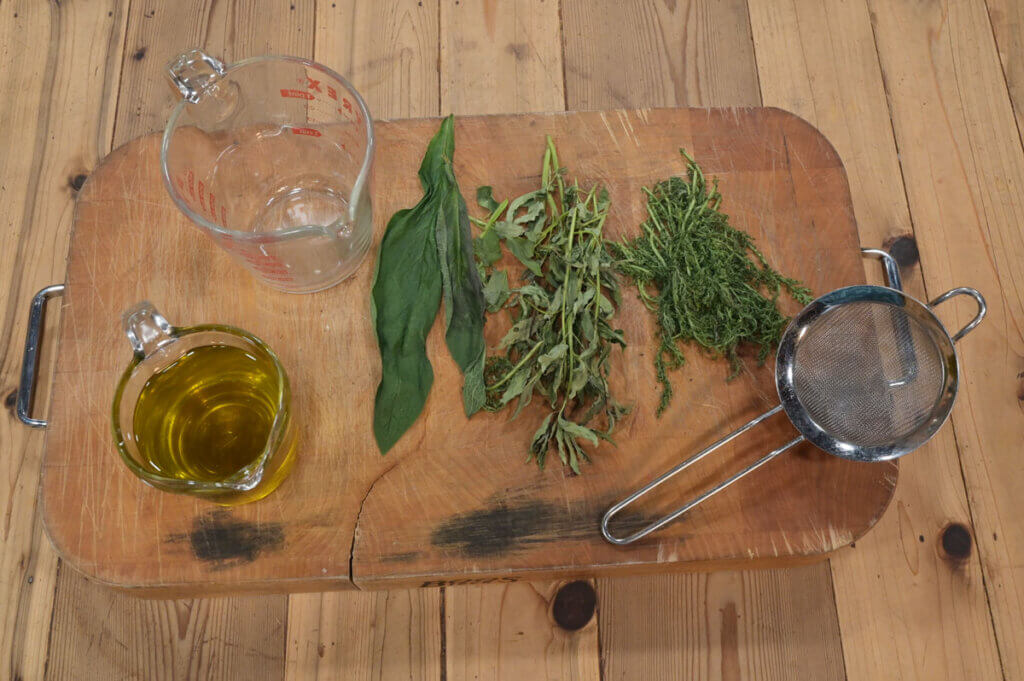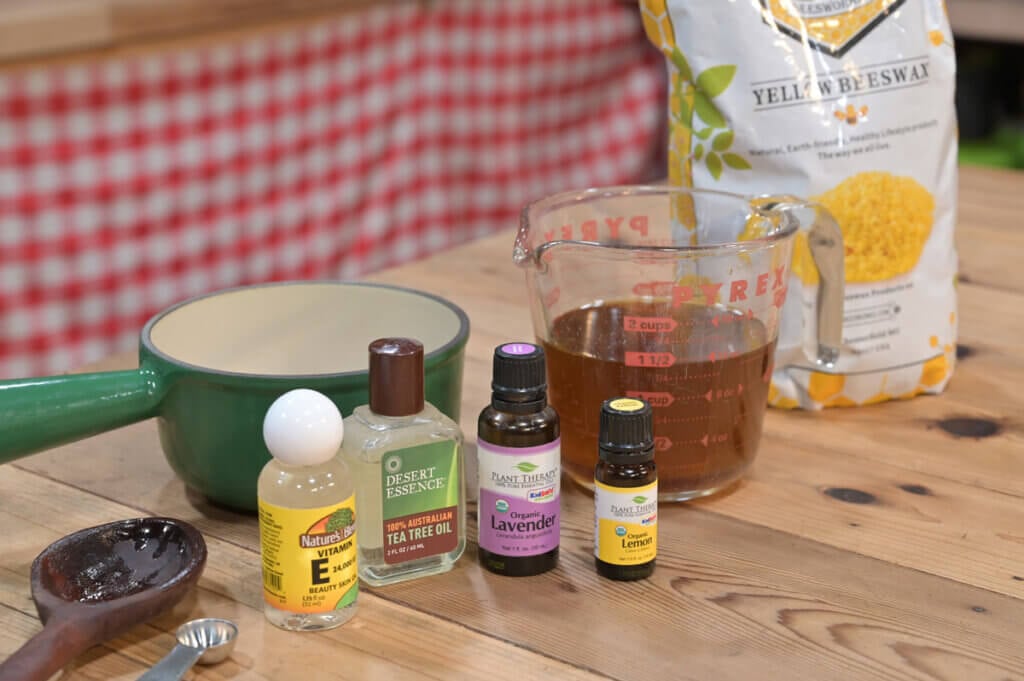
Ditch over-the-counter Neosporin and make your own healthy and soothing antibiotic ointment at home! This easy DIY is the perfect use for those home-grown medicinal herbs (or easily use dried herbs you can buy in bulk).

Why I Love This Home Remedy
Though the idea of an antibiotic ointment like Neosporin is great, having antibiotics in a base of petroleum jelly is not how I want to heal my children or myself. Furthermore, I’m not interested in contributing to antibiotic resistance.
It’s time to toss out the Neosporin and make our very own safe and effective natural version!
The more I use herbs and homemade herbal remedies in our everyday life, the more I’m convinced these OTC medications aren’t necessary.
It’s no surprise by now that we love herbs. We love planting medicinal herbs in our cottage garden. From these herbs (as well as some that we forage), we love making things like this easy home remedy for allergies (and Hay Fever), this DIY elderberry syrup, this medicinal hop tea, this Amish home remedy for chest congestion, and this garlic salve that’s a fantastic cough remedy.
It’s important to note that I am not a certified medical practitioner. This post is not intended to diagnose or treat but is for informational purposes only. Please contact your healthcare professional before introducing new herbal and natural remedies into your wellness routine.

Why Is Neosporin Bad
Antibiotic ointments have been shown to contribute to the rising occurrence of antibiotic resistance (Source), which is something that we should all be concerned about. Luckily, we have other very safe options for minor cuts and scrapes… and that is a homemade antibiotic salve!
Neosporin Allergy
Not only is Neosporin contributing to antibiotic resistance, but many people suffer from allergic reactions to Neosporin. According to Skin Wellness Physicians, “It’s the neomycin! Neomycin frequently causes allergic reactions of the skin called contact dermatitis. It can cause the skin to become red, scaly, and itchy. The more Neosporin you use, the worse the skin reaction gets.”
Now I don’t know about you, but I’d like to have peace of mind about the ointments and salves I’m using on my family.

Herbs Used for DIY Antibiotic Salve
This antibiotic salve is comprised of three main herbs, along with a few other ingredients we’ll discuss below. If you’re not already growing these herbs at home, you can purchase everything you’ll need for this recipe here.
Monarda (aka Bergamot or Bee Balm)
The Bee Balm plant is absolutely amazing. Native Americans used monarda for its antiseptic properties; it’s a natural source of thymol, the primary active ingredient in modern mouthwash formulas. They brewed a tea to help with mouth and throat infections.
Monarda is an antibacterial, antiviral, antifungal (Source), anti-inflammatory (Source), and antioxidant. (Source) It supports the immune system, and many people use it to treat colds and the flu. The leaves are used as an infusion in tea to help relieve insomnia, menstrual pain, nausea, and flatulence.
This makes Monarda a great herb to use on any wounds that are inflamed or angry.
Purchase organic dried wild Bergamot/Bee Balm here.

Yarrow
Yarrow is incredible for wound care, and we use it often for first-aid in our house. It stops bleeding incredibly fast (Source), heals wounds quickly, and reduces inflammation. (Source) It also includes some antibiotic properties. (Source)
A great thing about yarrow is you can use both the leaves and the flowers. So if your yarrow hasn’t bloomed yet, you’re still good to grab some of the leaves and use them in this recipe.
Purchase organic dried yarrow here or learn how to cultivate yarrow.
Comfrey
We keep comfrey growing under our fruit trees. It helps bring up minerals from the earth with its large taproot, making them accessible for fruit trees. As the leaves die back, it also composts around the fruit tree, leaving nutrients for the tree to use.
Comfrey is a fantastic wound healer. It actually speeds up your cell regeneration, making cells heal and repair much faster than they would on their own. (Source) Because it speeds up wound healing, you should not use comfrey on deep wounds or puncture wounds.
Comfrey is a fantastic skin soother that decreases inflammation and thereby decreases pain. (Source)
For minor cuts, scrapes, burns or bruises, it is an excellent herb. Check out our bone-healing comfrey compress remedy and soothing burn salve.
Purchase organic dried comfrey here.

Other Herb Options
This is an incredibly versatile salve. If you don’t have access to all three of these herbs, there are some additional herbs that will still work great for this homemade antibiotic ointment.
- Chamomile
- Clevers
- Calendula
- Thyme
- Oregano
Basically, any herb with antibiotic and soothing properties will work for this antibiotic salve recipe. (Learn the best methods for growing oregano, growing calendula, growing thyme, and growing chamomile.)

Herbal Oil
For this recipe, we’ll start by making an herbal oil. Because oil and water don’t mix, it’s important to allow your herbs to wilt for 3-12 hours prior to making the herbal oil. If you skip this step, your oil could end up going rancid or getting moldy.
You can also use dried herbs to make this salve, but that’s not necessary unless you don’t have these herbs growing in your garden or yard. See below for amounts and recommendations on where to buy dried herbs.
For this oil, we’re using a “Simpler’s Method,” which, for our purposes, means we’re not getting too fussy about the measurements. We’re simply tearing up the fresh herbs we have available and putting them into a jar in equal amounts until the jar is half full.

How to Make an Herbal Oil
- Tear the wilted herbs and fill up a clean Mason jar.
- Add oil until the herbs are just covered with olive oil (or another oil of your choice).
- Add a two-piece lid and label the jar with the contents and the date (I simply wrote “Antibiotic Salve Oil”).
- Shake the jar once or twice a day to make sure all herbs are under the oil and to displace any mold that may be trying to grow.
- After four weeks, strain the herbs out of the oil, pressing firmly on the herbs to get all the oil out.
To Make Oil Using Dried Herbs: If you’re using dried herbs to make an herbal oil, simply fill up a pint-sized Mason jar 1/3 full of equal parts herb and add one cup of oil.
The great thing about making medicinal oils is they can be used directly on your skin or in homemade soaps and salves. The herbal oil will last on the shelf (out of direct sunlight) for about a year. After the one-year mark, the medicinal properties will begin to decline, so it’s best to make as much herbal oil as you think you’ll need for one year.

Ingredients Needed
- Herbal Oil: This herbal oil should be made about four weeks prior to making this antibiotic ointment.
- Essential Oils (optional): I like using a combination of lavender, tea tree and lemon essential oils. The lavender not only soothes but also works as a pain reliever (Source) and is antibiotic, anti-viral, anti-fungal, and antibacterial. (Source) The tea tree essential oil is known for its anti-fungal, anti-viral, antibiotic and antibacterial properties. (Source) The lemon essential oil has antibacterial and antioxidant properties. (Source)
- Vitamin E Oil: This oil aids in healing the skin and might reduce any scarring from a minor injury. (Source) It is an antioxidant that helps prevent oils from going bad, keeping the medicinal properties strong for up to two years. (Source) Purchase vitamin E oil here.

Supplies Needed
- Mason Jar w/ Lid: Be sure the Mason jar is incredibly clean prior to making the oil. We don’t want to introduce anything into our salve! I like to use wide-mouth half-pint jars. You can also store salve in these 1-ounce metal salve tins and make them as gifts for family and friends.
- Small Heavy-Bottomed Pan: Some people like to have a designated pot for making herbal remedies at home. I find this isn’t necessary, as long as you give it a good solid cleaning with hot soapy water afterward. Alternatively, you could create a double-boiler with a pot and a metal bowl.

Homemade Antibiotic Ointment Directions
- In a small pot, melt the beeswax and herbal oil over very low heat.
- Once melted, take the pot off the heat source and allow it to cool for a minute or two.
- Add the tea tree oil, vitamin E oil, lavender oil, and lemon oil, stirring with a wooden spoon.
- After the oils are thoroughly mixed, pour into a small sterilized container, and let it cool until solid.
- Add a lid and label it with the contents and the date!
- Store in a cool and dark place for up to 2 years.

How to Store Homemade Antibiotic Salve
I like to use small glass Mason jars (8-ounce wide-mouth jars) with a two-piece lid. With 11 children in our home, and a busy homestead lifestyle, we get a lot of cuts, scrapes and bruises, so we go through a lot of antibiotic ointment.
The salve can be stored in the medicine cabinet, out of direct sunlight, for up to two years. Because we’ve added vitamin E oil, the medicinal properties of the oil will have a longer shelf-life. If you don’t have vitamin E oil, the antibiotic salve should last for about a year.
The medicinal properties will always be strongest immediately after making, so you can also make smaller batches more frequently to increase the potency. These metal salve tins would be perfect for smaller batches.

How to Use Homemade Antibiotic Ointment
To use your homemade antibiotic ointment, use just as you would Neosporin. Put it on minor cuts, scrapes or bruises to speed up healing. But remember to avoid adding it to deep puncture wounds.
Did you make this remedy? If so, please leave a star rating in the recipe card below. Then snap a photo of your homemade antibiotic ointment and tag us on social media @homesteadingfamily so we can see!

More Herbal Remedies You May Enjoy
- How to Get Rid of Headaches (Homemade Headache Salve)
- Homemade Arnica Salve
- Dandelion Uses for the Homestead
- Soothing Burn Salve – Relief for Skin Burns
- Medicinal Uses for Rose Petals
- DIY Lip Balm: Easy Homemade Recipe Guide
- DIY Rose and Honey Face Wash (For Dry & Aging Skin)

Homemade Antibiotic Ointment
Equipment
- 1 Heavy bottomed pot
- 2 Mason Jars & Lids half-pint, wide mouth
Ingredients
- 1 cup herbal oil see post for details
- 5 ounces beeswax pellets
- 50 drops tea tree essential oil about 1/2 teaspoon
- 25 drops vitamin E oil
- 20 drops lavender essential oil
- 10 drops lemon essential oil
Instructions
- In a small pot, melt the beeswax and herbal oil over very low heat.
- Once melted, take the pot off the heat source and allow it to cool for a minute or two.
- Add the tea tree oil, vitamin E oil, lavender oil, and lemon oil, stirring with a wooden spoon.
- After the oils are thoroughly mixed, pour into a small sterilized container, and let it cool until solid.
- Add a lid and label it with the contents and the date!
- Store in a cool and dark place for up to 2 years.


















